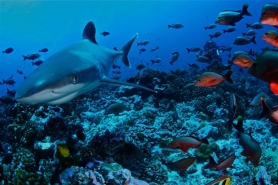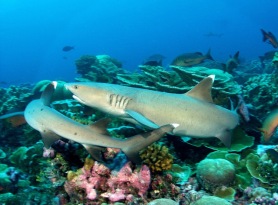Guest post by Emmeline Johansen, Conservation International
In April of this year, the Government of New Caledonia approved various laws to reduce the exploitation of sharks in their waters. This folllowed notable declines in catch rates and average sizes of sharks around New Caledonia, likely due to heavy fishing, which heightened national concerns for the sustainability of shark populations.
The new law has essentially created a shark sanctuary by banning fishing of all shark species in the country’s entire exclusive economic zone. At 1.2 million square kilometers (480,000 square miles), an area roughly the size of South Africa, the ocean around New Caledonia is still healthy and intact, and home to spectacular marine life, including approximately 50 species of sharks – this move will help to keep it this way.
The new laws ban the fishing, taking, possession or sale of all species of sharks. This includes the prohibition of marketing, selling, purchasing and export of shark products,including jewelery. “Shark-finning,” which involves mutilating the animal by removing the fins, which are used to make shark fin soup, a popular dish in Asia, has been outlawed. “Shark-feeding”, a popular adrenalin-fuelled tourist activity is also banned.
These new laws mark a very a proud moment in New Caledonia’s marine history, which we at Conservation International applaud. I personally hope it is the first of many positive conservation decisions towards better conserving New Caledonia’s natural capital for the people that depend upon it.
Why sharks must be conserved
Sharks play a vital role as keystone species in our oceans. They are the top of the food chain and as such are essential for maintaining the natural balance in the ecosystem by keeping populations of other fish in check. Without sharks in this regulatory role, this delicate balance can be tipped, leading to a collapse of the food chain and species loss. In fact, a number of studies have demonstrated that the depletion of sharks can lead to the loss of commercially important fish such as tuna. For this reason, and many more, it’s very important that we in the Pacific international community continue to take steps towards improving protection for shark populations to reverse their current global decline.
Back to New Caledonia, in addition to ensuring that the marine ecosystems remain in balance, sharks could provide another lucrative win for the country. Shark ecotourism is becoming an economic boon to countries across the Indian Ocean and Pacific Ocean regions. According to a new global analysis shark watching is a major economic driver for dozens of countries, already generating $314 million annually. Projections are that shark-related tourism could more than double within 20 years, generating over $780 million annually.
In contrast to the growing ecotourism industry, the value of global shark catches is in decline, largely as a result of overfishing. Approximately 100 million sharks are killed every year.
Increasing shark protection regionally and globally
Encouragingly, beyond the steps of the New Caledonian Government, there have been other groundbreaking moves towards this goal.
At the regional level, the Western and Central Pacific Fisheries Commission (WCPFC) recently developed new actions to support shark protection, such as a prohibition on catches of some species, including silky sharks and hammerheads, mandating the use of shark bycatch mitigation methods, and prohibiting the removal of shark fins at sea. These actions influenced New Caledonia’s recent commitment and hopefully will lead to other such moves by other coastal states and territories in this region.
At the international level, unprecedented steps are being taken to protect sharks. This year, at the Convention on International Trade in Endangered Species (CITES) World’s Wildlife Conference in Bangkok in March, 5 commercially valuable shark species were brought under CITES controls.
The species included the oceanic whitetip (Carcharhinus longimanus), scalloped hammerhead (Sphyrma lewini), great hammerhead shark (Sphyrna mokarran), smooth hammerhead shark (Sphyrna zigaena) and the porbeagle shark (Lamna nasus), which had been harvested in huge numbers for their valuable fins and, in some cases, meat. From now onwards, they will have to be traded with CITES permits and evidence will have to be provided that they are harvested sustainably and legally.
This was a significant move as it was the first break in the gridlock seen in the meetings of previous years that had held up the protection of these economically important species, indicating that the global community is now looking to collaborate on addressing the plight of some of the most highly vulnerable sharks.
A week to consider why we need sharks
This week is the single week in the year where the world collectively ponders sharks, marvelling at their strength and unique character in the ocean, typically as a predator. Let’s also take this time to think about how they are essential to ocean health, economics, and in turn human well-being – and why for these reasons we must continue to take greater steps to conserve these essential and influential animals.





